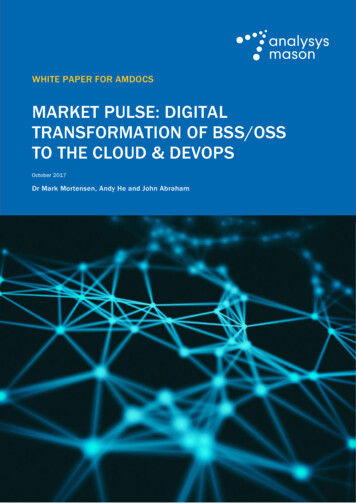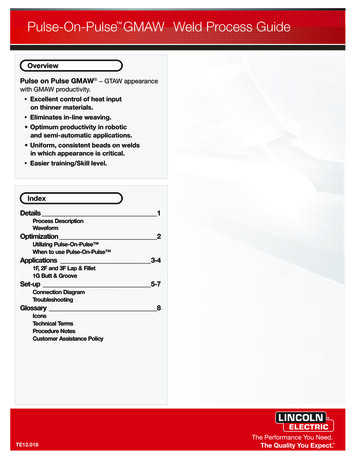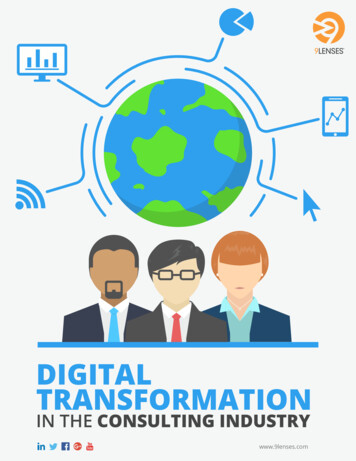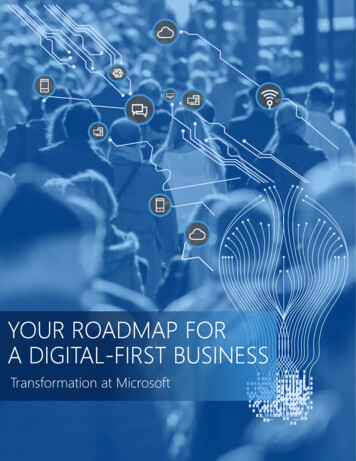
Transcription
WHITE PAPER FOR AMDOCSMARKET PULSE: DIGITALTRANSFORMATION OF BSS/OSSTO THE CLOUD & DEVOPSOctober 2017Dr Mark Mortensen, Andy He and John Abraham
Market Pulse: Digital transformation of BSS/OSS to the cloud & DevOps iContents1.Executive summary12.Competitive advantage through the cloudCloud is a key pillar of competitive advantages enjoyed by web-scale companiesCSPs face special challenges in adopting cloud and DevOps3343.Survey and interview results – transition to the cloud is inevitable, but will take timeCSPs will move their B/OSS stacks to hybrid and private clouds to reduce costsMost CSPs are implementing DevOps cloud processes and architectures in selected new areas6664.A model for BSS/OSS cloudification over the next five yearsCSPs are adopting one of three main approaches to B/OSS cloud migration and digitalisationAnalysys Mason’s estimation of CSPs’ B/OSS cloud maturity101011About the authors14List of figuresFigure 1: Estimation of BSS/OSS cloud maturity today and in five years’ time [Source: Analysys Mason,2017] . 1Figure 2: Microservices architecture [Source: Analysys Mason, 2017] . 4Figure 3: Location of the majority of BSS and OSS stacks, today and in five years’ time [Source: AnalysysMason, 2017] . 6Figure 4: Level of adoption of DevOps by CSPs [Source: Analysys Mason, 2017] . 7Figure 5: Pain scores associated with the move to cloud-native architecture and DevOps processes [Source:Analysys Mason, 2017] . 8Figure 6: Drivers for adopting cloud-native architecture and DevOps processes [Source: Analysys Mason,2017] . 8Figure 7: CSPs’ view of CICD [Source: Analysys Mason, 2017] . 8Figure 8: Migration plan for B/OSS to microservices architecture [Source: Analysys Mason, 2017] . 9Figure 9: Percentage of CSPs’ B/OSS stacks built on microservices by 2022 [Source: Analysys Mason,2017] . 9Figure 10: CSP awareness of bi-modal operations [Source: Analysys Mason, 2017] . 9Figure 11: Estimation of BSS/OSS cloud maturity today and in five years’ time [Source: Analysys Mason,2017] . 12Figure 12: Amdocs cloud maturity model [Source: Amdocs, 2017] . 13 Analysys Mason Limited 2017Contents
Market Pulse: Digital transformation of BSS/OSS to the cloud & DevOps 11. Executive summary“Software is moving to the cloud” is an oft-repeated phrase today. But just how fast are today’s business supportsystems (BSS) and operations support systems (OSS) making that move? This white paper characterises thatmovement. It is based on surveys and in-depth discussions between Analysys Mason and mostly top-tiercommunications and media service providers (CSPs) in North America, Asia–Pacific and Europe. Althoughmost top-tier CSPs are using new cloud technologies, we found that only a few are progressing rapidly, mostlydue to their legacy software, people and processes. We expect that those few leaders which have emerged willbecome much more agile and cost effective in their operations, opening a gap between them and theircompetitors. Our assessment of BSS/OSS cloud maturity today, and how it is likely to evolve over the next fiveyears can be seen in Figure 1.Software computinginfrastructureSoftware developmentprocesses2017WaterfallFigure 1: Estimation ofBSS/OSS cloud maturitytoday and in five years’Physical servertime [Source: AnalysysMason, 2017]2022AgileDevOpsVirtualCloudOur research indicates that movement to the cloud is best characterised by three major aspects: Software development and implementation processes – DevOps: moving from waterfall through agile toleading-edge DevOps processes. This includes the concept of continuous integration/continuousdeployment (CI/CD). We found DevOps to be part of most CSPs’ IT organisations, but not widelydeployed. The transition to DevOps will put stress on IT organisations, which will have to live withbi-modal, or even tri-modal operations organisations. Software technological infrastructure – cloud-native architecture & microservices: transitioning frommonolithic software architectures to a modern loosely coupled software architecture called “cloud native.”This includes the concepts of automatic scaling in cloud environments, enhanced reliability andmicroservices. These characteristics are highly desired by CSPs, and CSPs are deploying them today in thenew digital parts of their BSS/OSS architectures. Software computing infrastructure – cloud computing: the move from on-premises dedicated processorsto virtualised private data centres is well underway, aimed at reducing data-centre costs. BSS is leading themovement to true cloud deployment (private, public or hybrid cloud), enabling CSPs to pick up furtherbenefits. OSS is following, driven by network function virtualisation (NFV). But the movement of OSS tocloud deployment will happen slowly, due to the large legacy system infrastructure.The need to “stretch” IT organisations to accommodate both legacy and leading-edge software will strain CSPs’resources. CSPs view both systems integrators and software vendors as key partners in making the transition tothe cloud, which will require major changes to the IT organisational structure and to the skill sets of personnel. Analysys Mason Limited 20171: Executive summary
Market Pulse: Digital transformation of BSS/OSS to the cloud & DevOps 2The move to these new technologies will be accomplished through a combination of new systems andrefactoring of legacy systems to introduce the new software technology.Amdocs has developed a cloud maturity model for communications and media service providers. It provides adetailed framework for understanding the three major aspects of the move to cloud, while enabling serviceproviders to assess where they are in the journey and the benefits they would gain from progressing further (seeAppendix A). This white paper provides timescales for mainstream adoption of the various steps in the model,based on market data collected by Analysys Mason.2
Market Pulse: Digital transformation of BSS/OSS to the cloud & DevOps 32. Competitive advantage through the cloudCloud is a key pillar of competitive advantages enjoyed by web-scale companiesWeb-scale companies that have grown up in the cloud environment, over the last ten years, have evolvedsoftware development processes, software architecture and software deployment infrastructures. These elementshave been applied to the business platforms that form an intrinsic part of their business – in fact, in many waysthey are the business. It is impossible to imagine Uber without its ride-sharing software,1 Netflix without itsvideo streaming engine,2 or Amazon without its recommendation system. These systems bring tremendouseconomies of scale through an integrated, highly automated software platform that incorporates all of theprocesses of the business. These companies, and others like them, have pioneered new ways of designing,developing and deploying software to give them great agility in their business, yet large economies of scale.There are three particular areas which characterise this new way of doing business: DevOps processes, cloudnative software architectures and cloud deployment, as discussed below.Web-scale companies pioneered DevOps processesGoogle operates some of the most reliable data centres in the world, which are key to ensuring that its servicesare ‘always on’. The core principles of Google’s operations are encapsulated in the company’s site reliabilityengineering paradigm, which espouses the idea of building software products with an operations mindset. Thisphilosophy, more popularly known as DevOps and widely adopted by other web-scale companies such asAmazon, brings the software development and operations functions together right from the start of the productlifecycle. Google’s operations team basically consists of a group of software engineers who apply theirprogramming skills to automate repetitive manual tasks, thus removing the business risk of manual errors duringoperations.Web-scale companies have built software platforms with cloud-native technologiesWeb-scale companies have launched services with a rapid iteration cycle with a high level of resilience for theircustomers (who outnumber the customer base of most CSPs). This has come from a way of architectingsoftware from the next generation beyond three-tiered client/server technology, known as “cloud native.”Uber originally relied on a monolithic software architecture for its operations, which was designed for a singleoffering, UberBlack. But as Uber’s business footprint expanded across the world, it migrated to a flexible andscalable cloud-native architecture. Key to that new architecture is the concept of microservices, which enablerapid, reliable and independent software releases across regions.A microservices architecture (see Figure 2) enables the creation of small and highly granular functional softwaremodules (e.g. performance analysis, log analysis, reporting) that can be used to compose applications (e.g. aservice quality monitor, or an application for dispatching engineers). By its nature, a microservice is selfcontained and highly available, enabling it to be configured, scaled, enhanced and replaced independentlywithout affecting the availability and reliability of the cloud-native applications of which it forms a part.1Uber, through its cab-hailing and car-sharing platform, provides 40 million rides per day across 633 cities in 78 countrieswithout owning a single vehicle. Uber’s valuation was over USD70 billion in June 2017.2Netflix has 120 million hours of video streaming across over 190 countries every day. While Netflix transformed from an onlineDVD rental business to a subscription-based OTT video business, its arch rival Blockbuster filed for bankruptcy in 2010 andmillions of US households cut the cord on expensive cable-TV packages. Netflix’s market capitalisation was just overUSD600 billion in June 2017.3
Market Pulse: Digital transformation of BSS/OSS to the cloud & DevOps 4Figure 2: ure [Source:Analysys Mason, 2017]App3App1AEHCFBMicroservice BAPIServiceDMicroserviceApp2GInternal API callsHowever, if such an architecture is to function effectively, the microservices must interlink and communicatewith one another using application programming interfaces (APIs). APIs are one of the most powerful featuresof microservices, which enable them to be dynamically called by other microservices as part of a largerapplication. Security, quality of service, service call metering, transaction management and other functions aremanaged by smart API frameworks and gateways.Web-scale companies deploy business platforms in the cloudWeb-scale companies all deploy their business platforms on virtualised data-centre infrastructures that have theadvantage inherent lower cost and automatic scaling and reliability features. Some are using private clouds,while others use public clouds. For instance, Netflix migrated all aspects of its streaming services – rangingfrom customer-facing services to billing infrastructure – to Amazon Web Services between 2008 and 2016; incontrast, Alibaba, the Chinese e-commerce behemoth, started building its public cloud services in 2009 and nowruns most of its core applications on Alibaba Cloud.Without software that is designed for the cloud (not just “cloud ready”), it is difficult for web-scale companiesto achieve the required reliability, however.CSPs face special challenges in adopting cloud and DevOpsIn the past, it was widely believed that non-telecoms software could not provide the reliability and scalabilityrequired for CSPs’ operations. Today, however, web-scale companies operate at sizes and transaction rates thatexceed those of CSPs in some areas, and the reliability of their operations has vastly improved. Nevertheless,there are still some critical differences between web-scale companies and CSPs, due to their heritage.LegacyWhile young web-scale companies have recruited mostly young people and implemented the latest software thatthey largely wrote themselves, CSPs have a substantial legacy of both. Their software systems are a patchworkof home-grown systems and systems bought from a large number of vendors over a long period of time (somemore than 30 years ago). This puts a special burden on CSPs in terms of upgrading both these systems and theskills of their staff. CSP businesses have many ‘moving parts’ that require substantial planning, execution effort,as well as capex and opex.4
Market Pulse: Digital transformation of BSS/OSS to the cloud & DevOps 5RegulationWeb-scale companies are only lightly regulated, whereas CSPs face extensive regulatory oversight, much of itfrom decades ago. Regulations – especially those relating to consumer privacy – restrict storage methods andgeographical data placement, while privacy concerns severely limit how CSPs can use customer information.Organisational structureCSPs are organised in many silos, associated with function, customers served and technologies employed. Eachof these different organisations within a CSP has been working for decades to automate its activities. As a result,it is difficult to fund and implement modern, automated processes that transcend the boundaries between theindividual silos. In contrast, web-scale companies are organised around their software platforms, which followbusiness process flows, free from the silo effect.5
Market Pulse: Digital transformation of BSS/OSS to the cloud & DevOps 63. Survey and interview results – transition to the cloud isinevitable, but will take timeCSPs will move their B/OSS stacks to hybrid and private clouds to reduce costsData centres are rapidly virtualising and automating the administrative processes which support BSS and OSSapplications. Although both BSS3 and OSS4 are moving to the cloud, our research shows that BSS is furtherahead than OSS. But network function virtualisation (NFV) will accelerate the movement of OSS to cloudcomputing, as shown in Figure 3.Figure 3: Location of the majority of BSS and OSS stacks, today and in five years’ time [Source: Analysys Mason,2017]BSS100%OSS100%Third-partyprivate cloud90%90%Hybrid cloud80%70%Ownvirtualiseddata centre60%Hybrid cloud50%40%30%Physicalserver20%Own privatecloud10%Share of operatorsShare of operators80%Ownvirtualiseddata centre70%60%50%Own privatecloudPhysicalserver40%30%20%10%0%0%TodayIn five yearsTodayIn five yearsCSPs expect very few BSS and OSS to run in a public cloud -- hybrid cloud will dominate in BSSCSPs stated that concerns over data privacy were a primary factor that will stop them from moving to publicclouds, making the option of hybrid cloud popular. A CSP’s applications can only be run in a public cloud if it isdeployed as SaaS, or a managed service.Most CSPs are implementing DevOps cloud processes and architectures inselected new areasAlmost all the CSPs that we contacted said they do have teams using DevOps and developing cloud-nativearchitecture – but only in selected areas. Several expressed some scepticism that DevOps will establish itself as3BSS are those systems that support the business and customer operations. They are usually considered to include revenuemanagement and customer-care systems.4OSS are those systems that support the service and network operations. They usually include service fulfillment, servicedelivery platforms, element and network management systems (EMS and NMS), and a new generation of networkorchestration systems.6
Market Pulse: Digital transformation of BSS/OSS to the cloud & DevOps 7best practice for all domains, citing traditional assumptions regarding the quality advantages of separatingdevelopment from testing and deployment. This shows that there is still an ongoing mind shift among CSPs.Many CSPs are still migrating from waterfall to agile, with DevOps trials limited to a small scaleMany IT organisations still use waterfall methodology, but they do wish to move to agile processes, which theyfeel have been proven. DevOps is mostly being used in new areas of software development, especially in digitalexperience areas such as portals, connecting both internal resources (such as catalogue or ordering) and externalresources (such as suppliers and partners). Figure 4: Level of No to DevOpsadoption of DevOps byYes to DevOpsCSPs [Source: AnalysysMason, 2017]45%27%18%9%The need to justify the business case and a lack of organisational readiness are inhibiting DevOpsimplementationA number of factors are in play which inhibit the wider roll-out of cloud-native architecture and DevOpsprocesses, as shown in Figure 5. The need to justify the business case for the move and the difficulty of runningbi-modal operations are tied as the largest inhibitors. The need to reorganise the current siloed structure of ITorganisation and improve skill sets are not far behind.7
Market Pulse: Digital transformation of BSS/OSS to the cloud & DevOps 8Figure 5: Pain scores5 associated with the move to cloud-native architecture and DevOps processes [Source: AnalysysMason, ing thebusiness ctureSkills scarcity inthe IT organisationTechnologymaturityDespite their desire for greater business agility (see Figure 6), most CSPs are not yet ready for continuoussoftware releases, which require them to receive new code from vendors and deploy it in their live operationenvironment every few weeks, over the next two to three years (see Figure 7).Figure 6: Drivers for adopting cloud-native architectureFigure 7: CSPs’ view of CICD [Source: Analysys Mason,and DevOps processes [Source: Analysys Mason, 2017]2017]Traditional methods willremain for 2–3 years45%We will bundle changes andtest every 6–12 months for2–3 years27%Our operations are notpositioned to acceptcontinuous releases9%Wanted for new systems assoon as possible9%Required for news systemsand wanted for legacysystems9%Most CSPs plan to have new B/OSS stacks built on microservice architecture in five years, if not soonerCSPs are quite aggressive about having new B/OSS stacks on microservice architecture, as illustrated by thesurvey results in Figure 8 and Figure 9 below. Software application development using microservices5CSPs were asked about the top-three ‘pain points’ they foresee in moving to cloud-native architecture and DevOps processes.The first, second and third pain points were given a score of 1, 0.3 and 0.1 respectively.8
Market Pulse: Digital transformation of BSS/OSS to the cloud & DevOps 9architecture is currently the fastest way to develop and deploy software applications, and has matured at theright time to coincide with the digital transformation of CSPs.Using a microservices architecture in conjunction with DevOps software engineering principles, CSPs cansignificantly reduce the time needed to apply changes to the operations platform, as well as to develop newcode. As a result, they can shorten the time it takes to launch new services to the market.CSPs are aware of the challenges associated with the transformation to microservice architecture, particularlythe integration costs, more-complex interoperability, and the training associated with new functionality.Figure 8: Migration plan for B/OSS to microservicesFigure 9: Percentage of CSPs’ B/OSS stacks built onarchitecture [Source: Analysys Mason, 2017]microservices by 2022 [Source: Analysys Mason, 2017]Nice to have40%100%35%90%30%70%Share of operatorsShare of operators80%60%Required fornew �2 yearsBy 20225%Required for newsystems and wantedfor legacy system0%25% or less50%75%100%CSPs will have a difficult time managing bi-modal or tri-modal operationsCSPs also realise that it will be challenging to operate traditional monolithic applications alongside new cloudnative applications, referred to as bi-modal operations (see Figure 10). Tri-modal operations, where CSPssimultaneously manage applications developed using waterfall, agile and DevOps methodologies, will alsoemerge as a major challenge: there will be a long period during which these approaches will co-exist, with aneed to ensure that new capabilities offer backwards compatibility with the existing IT ecosystem.Figure 10: CSPCritical issue: we will needto reskill our workforces64%Critical issue: we will needto rely on a third party27%Do not know9%Not an issue at all0%awareness of bi-modaloperations [Source:Analysys Mason, 2017]9
Market Pulse: Digital transformation of BSS/OSS to the cloud & DevOps 104. A model for BSS/OSS cloudification over the next fiveyearsWhen conducting the surveys and interviews, we sought to research the full range of approaches and attitudes,rather than focusing on leading players in the move to the cloud. The primary research data was analysed‘through the lens’ of the Amdocs cloud maturity model (see Appendix A). Here we present our findingsregarding BSS and OSS cloud deployment in the telecoms market, following the structure of the model.CSPs are adopting one of three main approaches to B/OSS cloud migration anddigitalisationCertain CSPs are moving very aggressively to the cloud, making major investments to move quickly andenlisting support from their software vendors. They believe that this transition can give them major competitiveadvantages, in the form of operational cost and business agility. These CSPs are typically also leading the shiftfrom CSP to digital service provider (DSP), by following digital transformation strategies.There is a major gap between these few companies and others in the industry. Most CSPs in the second groupare currently taking a more gradual approach before making major commitments, and they foresee a gracefulmigration to the cloud. They are typically making faster progress on the move to cloud infrastructure than on thetransition to DevOps. A third group, the sceptics, remain unconvinced of the rationale for moving to the cloud.A select group of “true believers” are aggressively moving to cloud to compete with web-scale companiesCertain CSPs see themselves gaining competitive advantage from a fast movement to the cloud and cloudtechnologies. For example, AT&T has embarked on a set of very disruptive endeavours, including: its ONAP6programme for network virtualisation, its BSS evolution programme (which made AT&T one of the leaders indigitalisation of customer experience), and its Workforce 2020 project to upgrade the skills of its employees.Others CSPs that have announced major strides include Verizon,7 Comcast8 and Vodafone.9 The approach takenby these leaders should enable them to compete on a host of new digital services, not only with other CSPs, butalso with web-scale companies.Most CSPs take a “hybrid” view, seeing themselves competing primarily with one another and thereforeforeseeing a more graceful migration to the cloudMany CSPs do not feel that the business case for cloud technologies is sufficiently proven to justify highlydisruptive moves. They do plan to move to the new technologies, often with considerable help from theirvendors, but they are adopting a more graceful path. This approach is not designed to equip them to competewith web-scale players on cost or agility, since they do not see web-scale players as major competitors. This6See http://about.att.com/innovationblog/onap7See tps://www.google.co.il/url?sa t&rct j&q &esrc s&source web&cd 7&cad rja&uact 8&ved 0ahUKEwj194e8gKLWAhXFSRoKHcZUCyYQFghMMAY&url 2Ffiles%2F2016-jenkins-worldverizons journey to enterprise grade devops.pdf&usg AFQjCNGE03o7RQyHS6l-ZD 42RAZzzzkyA id/7232288See ast/9See e-ocean-updates-and-next-steps10
Market Pulse: Digital transformation of BSS/OSS to the cloud & DevOps 11group of CSPs tends to see their services as mostly circumscribed by communications services and minorextensions.The sceptics are waiting and watchingAlthough all CSPs are studying and experimenting with the new technologies, a sizable minority remain in thesceptic category for now. They are adopting a ‘wait-and-see’ approach to DevOps, cloud native architecture andcloud deployment for their mission-critical BSS and OSS.Analysys Mason’s estimation of CSPs’ B/OSS cloud maturityUsing data acquired through primary research and our own internal research, we have estimated the distributionof CSPs at various steps along the migration journey, showing the distribution today and our forecast of how itwill evolve over the next five years.The main points from our forecast (summarised in Figure 11 on the next page) are as follows: The great majority of top-tier CSPs will adopt agile processes over the next five years, while leadingedge CSPs will move the majority of their development to DevOps processesOver half of top-tier CSPs will have cloud-enabled BSS applications five years from nowIn five years, the majority of OSS applications for virtualised networks will run in the cloudHybrid cloud will have replaced bare metal five years from now.11
Market Pulse: Digital transformation of BSS/OSS to the cloud & DevOps 12Figure 11: Estimation of BSS/OSS cloud maturity today and in five years’ time [Source: Analysys Mason, 2017]12
Market Pulse: Digital transformation of BSS/OSS to the cloud & DevOps 13Annex A Amdocs CSP cloud maturity modelThe model used in the surveys and interviews is based on the Amdocs cloud maturity model forcommunications and media service providers, a high-level version of which is provided in Figure 12 below.The Amdocs cloud maturity model shows the three evolutions happening in parallel – i.e. adopting cloudinfrastructure, evolving applications to cloud paradigms and transforming people and processes to DevOpspractices. The model enables CSPs to assess their current stage of maturity, as well as plan what steps they needto take – and when – to progress further.The Amdocs Cloud Centre of Excellence leverages deep communications industry and cloud expertise to helpleading CSPs globally with roadmap definition and technology selection. When the Amdocs Cloud Centre ofExcellence conducts advisory sessions with CSPs, it leverages the full cloud maturity model: this dives into thedetailed definition of each step to assist CSPs in mapping their maturity, while at the same time highlighting theassociated challenges and benefits to be gained from progressing to the next step.Figure 12: Amdocs cloud maturity model [Source: Amdocs, 2017]13
Market Pulse: Digital transformation of BSS/OSS to the cloud & DevOps 14About the authorsMark Mortensen (Research Director) is the Research Director and Practice Head forcustomer-facing systems in Analysys Mason’s Telecoms Software and Networks Researchstream. He is also the lead analyst for the Digital Experience research programme. His interestareas include the conversion of CSPs to modern DSP operations, the effect of networkvirtualisation on operations, and the evolution of software architectures in the cloud world.The first 20 years of Mark’s career were at Bell Laboratories, where he started software products for new marketsand network technologies, and designed the interaction of BSS/OSS with the underlying network hardware. Markwas Chief Scientist of Management Systems at Bell Labs, and has also been president of his own OSS strategyconsulting company, CMO at the inventory specialist Granite Systems, VP of Product Strategy at TelcordiaTechnologies, and SVP of Marketing at a network planning software vendor. Mark holds an MPhil and a PhD inPhysics from Yale University and has received two AT&T Architecture awards for innovative software solutions.He is also an adjunct professor at UMass Lowell in the Manning School of Management, specialising in businessstrategy. Mark has also participated on the GSMA Global Mobile Awards judging panel.Hansang (Andy) He (Consultant) is a member of Analysys Mason’s Custom Research team.He has contributed to a range of projects, with a focus on network virtualisation and digitaltransformation, ranging from business case studies, vendor evaluation to competitive landscapestudies and go-to-market strategies. Andy holds a Bachelor’s degree in Electronic andCommunications Engineering from the University of Bristol and a Master’s degree inManagement and Strategy from the London School of Economics.John Abraham (Senior Analyst) is part of Analysys Mason’s Telecoms Software and NetworksResearch team. He leads our Reve
WHITE PAPER FOR AMDOCS MARKET PULSE: DIGITAL TRANSFORMATION OF BSS/OSS TO THE CLOUD & DEVOPS October 2017 Dr Mark Mortensen, Andy He and John Abraham










